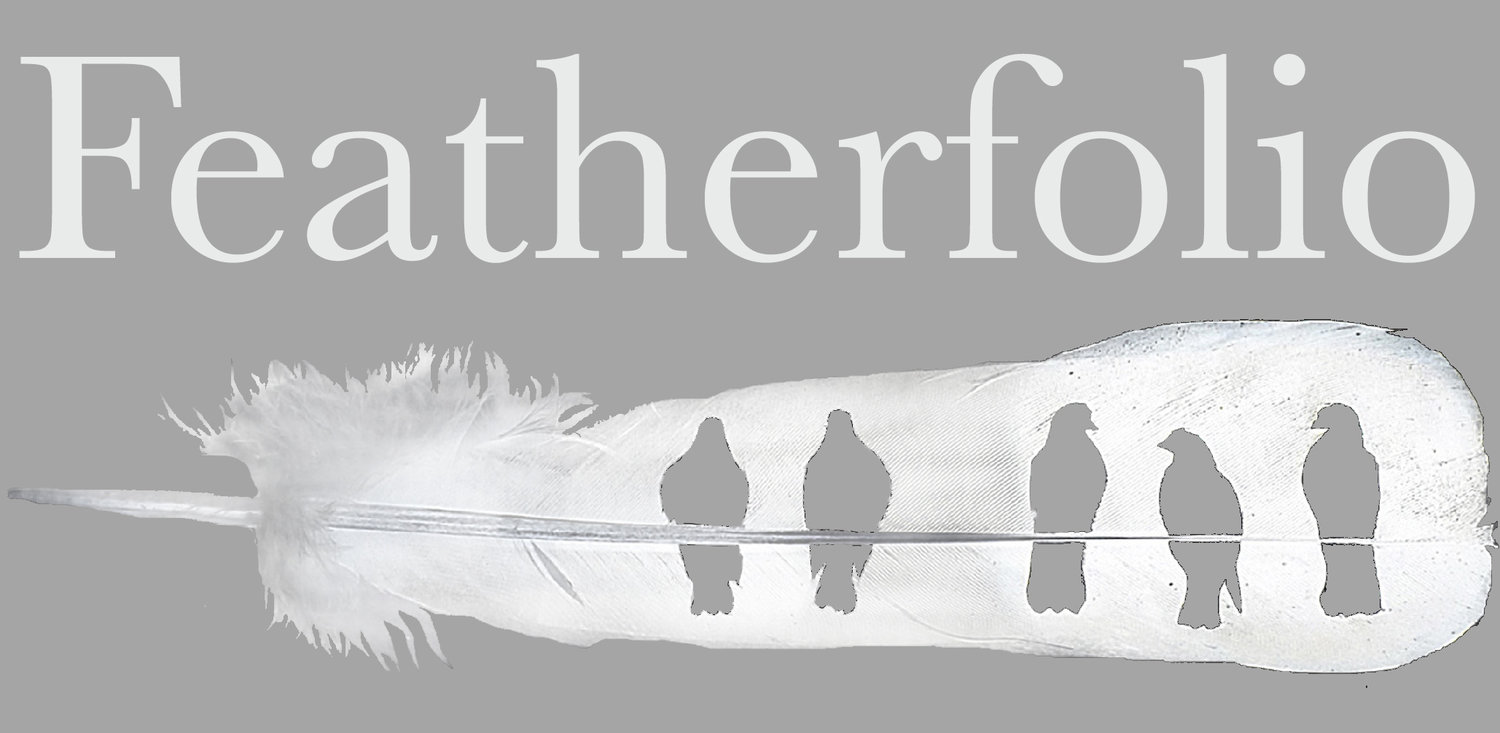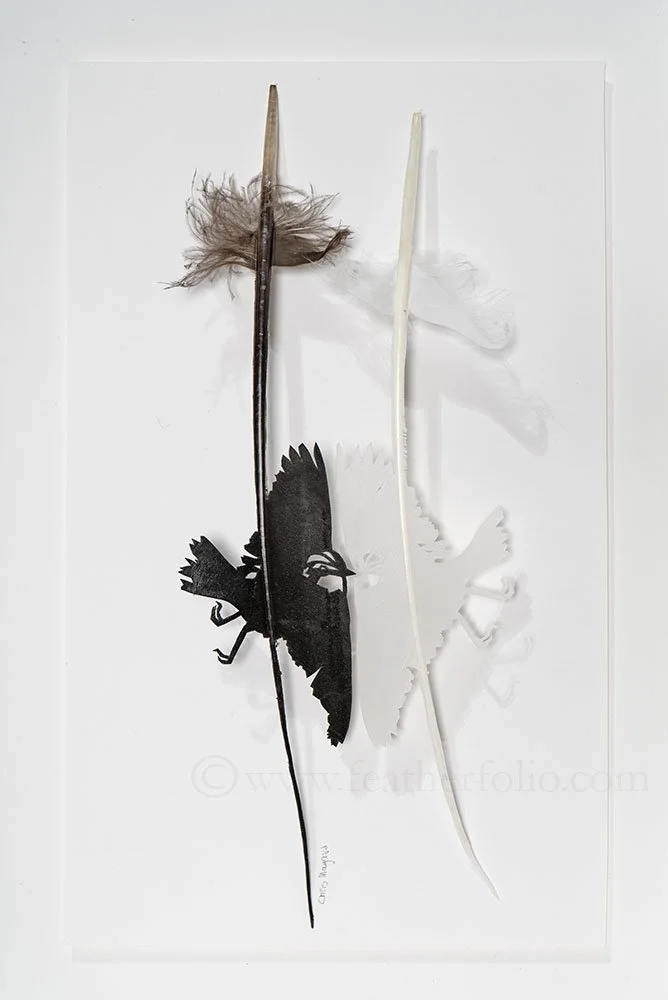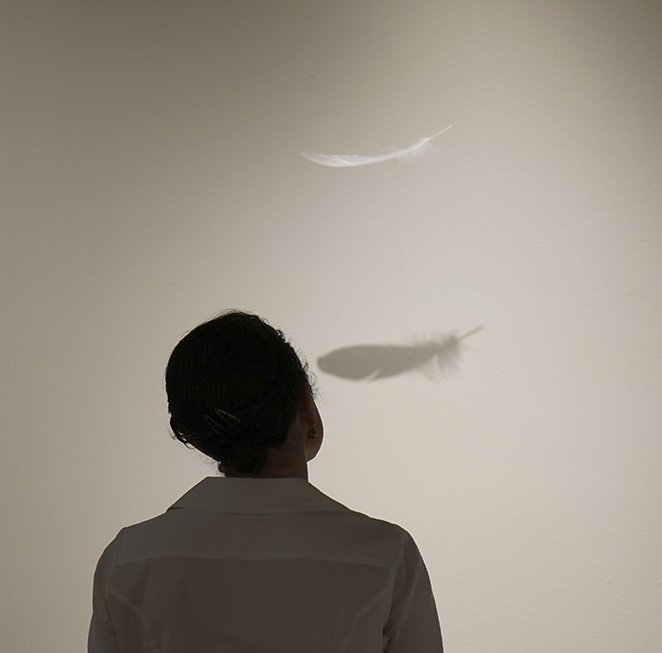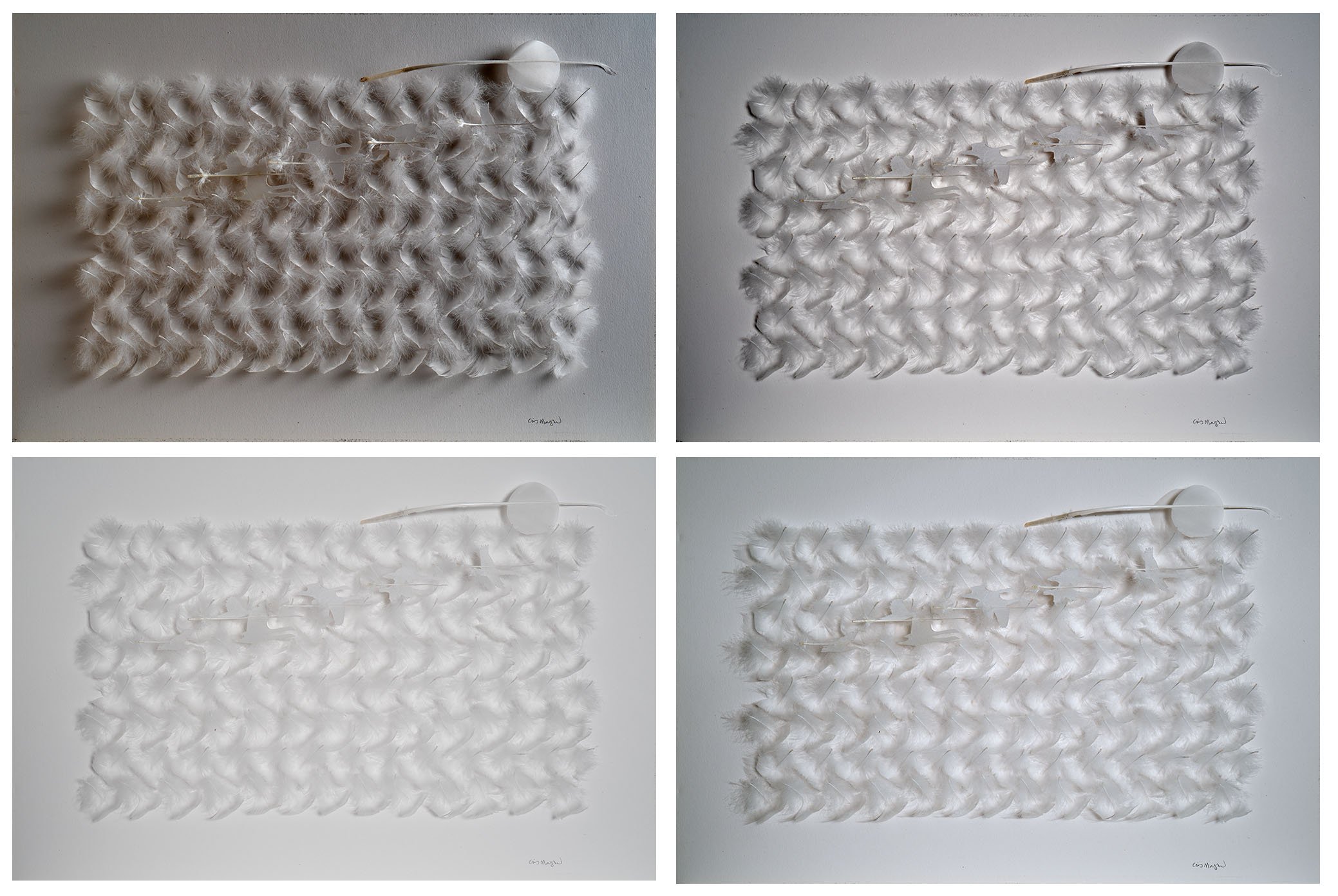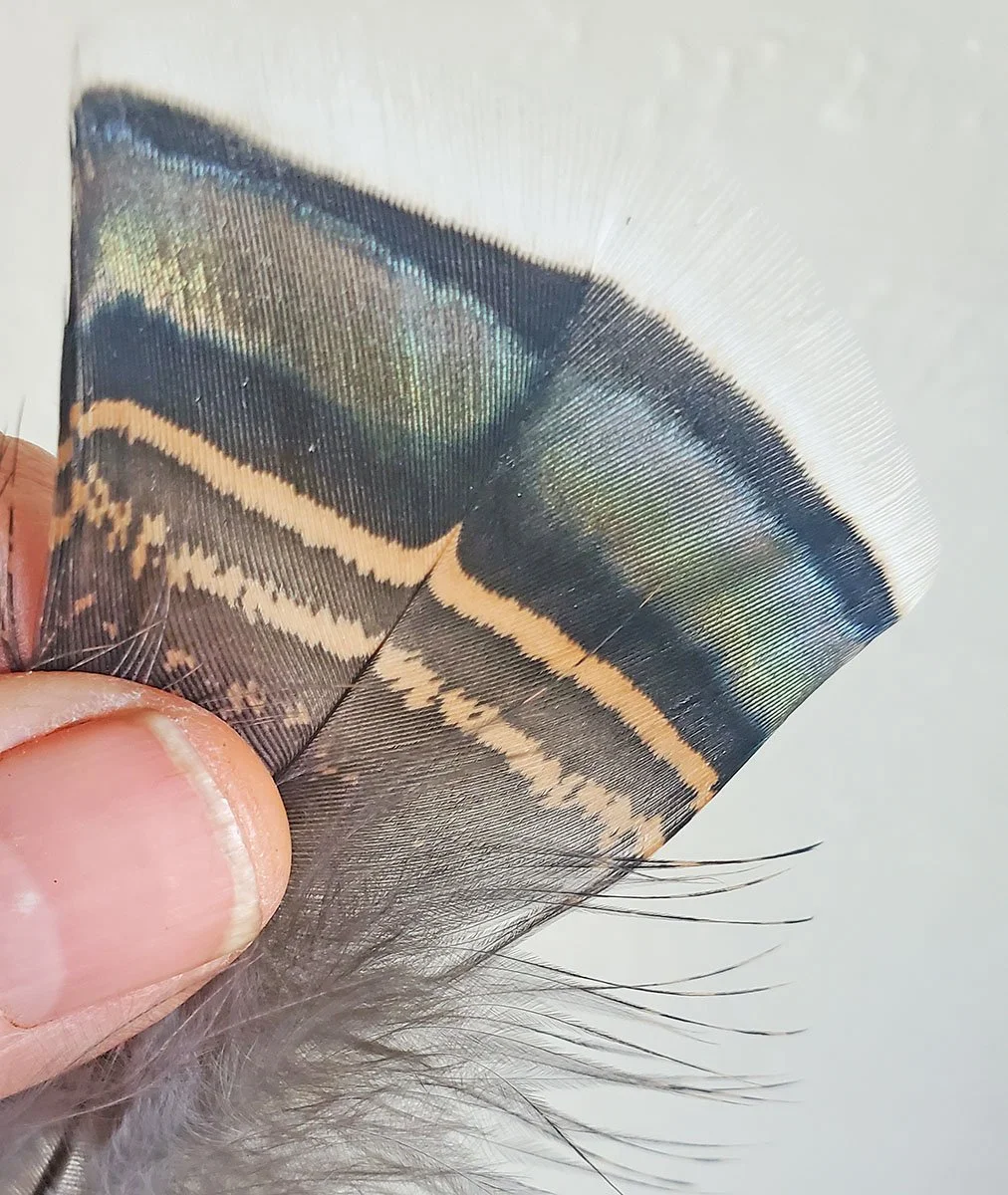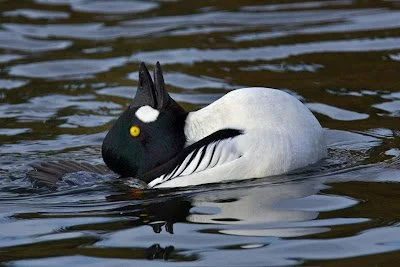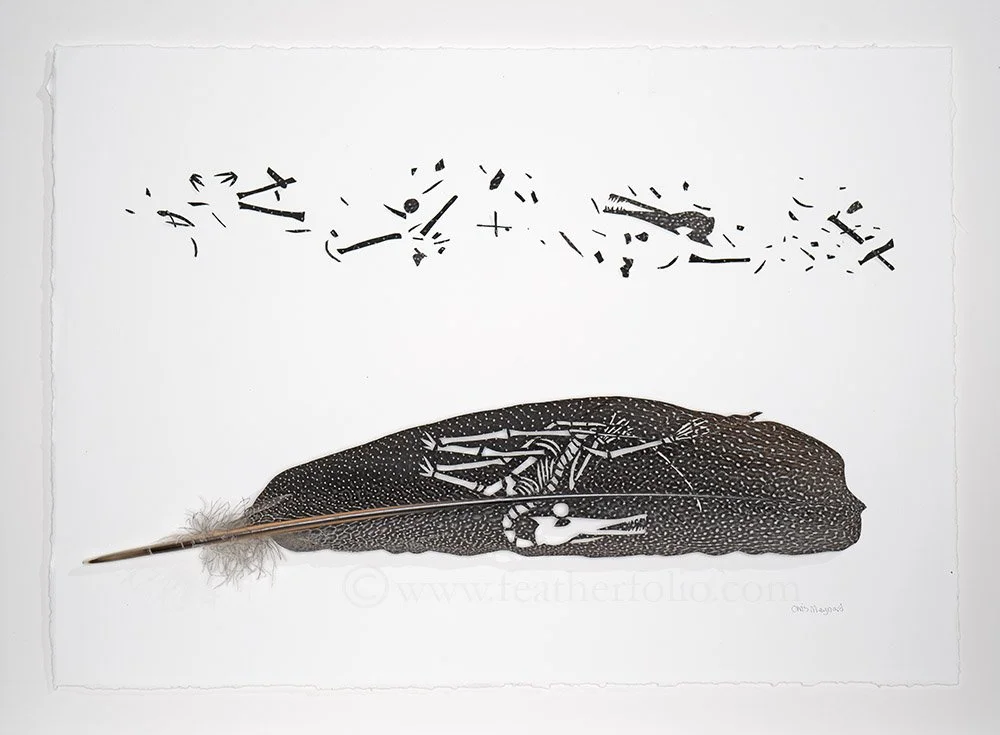Each bird sheds hundreds of feathers each year. What happens to them? This small ant is repurposing this huge feather for something, I don’t know what. I stall the breakdown of a few shed feathers by recycling them in my art. But for most feathers, mites, fungus, and many other small creatures eat them, turning them into food that plants use. Birds eat the plants and fruits and bugs that eat the plants, growing more feathers!
Like Water Off A Duck's Back. /
A thin layer of air is trapped by the microsculptural bumps on ducks’ feathers making for a silvery sheen (called a plasteron) when feathers are dipped into water. It’s about surface tension. But if a bird dives deeper than several meters, the pressure of the water overcomes the surface tension, potentially soaking the feathers. But the feathers still remain dry! How? The ability to stay dry under the pressures of deeper water has to do how the birds’ preen oil changes the pressure needed to fully soak the feather. This allows deep divers’ feathers to just shed the water when the bird surfaces rather than getting soaked. *
Bird Crashes into window /
The Window uses a turkey and a swan feather
A songbird flies along on its migration at night. Like a moth at night, is attracted to light of a city. What looks like a clear way forward isn’t. This piece, the “Window”. was inspired by Miranda Brandon’s epic photographic series underscoring this threat.
What Do you Call a Feather in Different Languages? /
veer, pluim. Afrikaans
ريش, ريشة Arabic
хӏули. Avaric
tük, lələk. Azerbaijani
пяро́. Belarusian
перо̀, оперявам. Bulgarian
ploma. Catalan, Valencian
péro. Czech
plu, pluf. Welsh
fjer. Danish
Vogelfeder, befiedern, Feder. German
πούπουλο, φτερό. Greek
plumo. Esperanto
pluma. Spanish
sulg. Estonian
luma. Basque
پر. Persian
vuohiskarva, sulka, tyyppi, lehti, höyhen. Finnish
fjøður. Faroese
plume. French
pinne, plom, fear. Western Frisian
cleite. Irish
ite Scottish Gaelic
ague. Guaraní
પીછું. Gujarati
נוצה. Hebrew
पर, पंख. Hindi
toll. Hungarian
փետուր. Armenian
pluma, penna. Interlingua
bulu. Indonesian
plumo. Ido
fjöður. Icelandic
penna, piuma. Italian
נוֹצָה. Hebrew
羽. Japanese
wuluJ. avanese
ბუმბული. Georgian
қауырсын. Kazakh
ស្លាប. Khmer
ಗರಿ. Kannada
유, 깃, 종류, 깃털 Korean
pûrt, پهڕ, perr. Kurdish
plūma, penna. Latin
Fieder, Plomm Luxembourgish, Letzeburgesch
ຂົນ, ບິກ Lao
plunksna Lithuanian
spalva. Latvian
перо. Macedonian
өд, өрөвлөг. Mongolian
bulu pelepah. Malay
အတောင်. Burmese
pluim, veer, veder. Dutch
fjør Norwegian Nynorsk
fjær. Norwegian
atʼaʼ. Navajo, Navaho
ਖੰਭ. Panjabi, Punjabi
pióro. Polish
pluma, pena. Portuguese
pană, fulg. Romanian
перо́. Russian
pinna, pinnia. Sardinian
перо, pero. Serbo-Croatian
pierko, pero. Slovak
pero. Slovene
pendë, pupël. Albanian
fjäder. Swedish
nyoya. Swahili
சிறகு. Tamil
ఈకT. elugu
пар. Tajik
ขน, ขนนก. Thai
ýelek. Turkmen
balahiboT. agalog
tüyT. urkish
перо́. Ukrainian
پنکھ, پر Urdu
lông chim, lông vũ, lông. Vietnamese
plüm, bödaplümem, pen, bödapen, bödaplüm, plümem. Volapük
pene. Walloon
פעדער. Yiddish
羽毛. Chinese
uphaphe. Zulu
I copied this off a site called Definitions.net
These are not hearts! /
ruffed grouse body feathers
We make sense of the world through symbols. These are beautiful natural heart shapes but for a grouse, they are not likely symbols of love but useful for hiding, for camouflage.
108 Species of Starlings! /
Did you know there are 108 species of Starlings? Most live in Africa. The science names of the starlings that donated these feathers for what I call my "Starling Poster" are:
Lamprotornis iris
L. nitens
L. purpureus
L. elizabeth
L. chakrurus
L. australis
L. acuticaudus
L. purpuroptera
L. regius
L. splendids
L. shelleyi
L. superbus
L. purpuriceps
L. ornatus
L. hidebranti
L. muesii
Cirmyricinolu leucogaster
Orychognathus walleri
Peoeptera stuhlmanni
Saroglossa spiloptera
These feathers were originally used in an ornithological study of feather evolution and were obtained from the American Museum of Natural History in New York.
Shadows /
Swan NIght Flight . Mute Swan body feathers
I owe a debt to shadows. Without them, my art would be flat and less appealing, poorer. As I think about this, I notice all around me the shadow of my fingers as I type on the keyboard; how the chair, the pencil, the wastebasket throw their bits of darkness to create a richer presence; that at night when the lights are off, I am enveloped in Earth’s shadow. I primarily work with feathers that usually symbolize the unshadowed part of existence like flight and air and light. Which is why shadows are so important in my work and life, to balance the light, the sky, and the heavens with the Earth and darkness.
Rattle the Cage, Birds as Pets /
Rattle the Cage, from my sister in law’s pet Blue & Gold Macaw tail feathers
Three and a half million pet birds live in the USA.* These are mostly caged birds like parrots in homes, not chickens and ducks. The numbers are slightly less than 20 years ago but about 3 in every 100 households have a bird or two. Practically all these birds are bred in captivity, not from the wild. People get them from pet shop, friends, and rescue centers.
Like keeping dogs as pets, owners love them. But birds have wings, so everyone wants to see them be able to fly and they mostly can’t in captivity. So there is an element of sadness as in, Why Does the Caged Bird Sing?
My friend caught a baby starling and fed it by hand until it grew up in its cage by the front door. It learned to talk and imitate interesting noises. It could fake her voice. Her husband was occasionally fooled when the bird imitated the door opening and voiced “Hello honey!”
*2017 Pet Ownership and Demographic Sourcebook by the American Veterinary Medical Association. Bird's Sense of Touch /
We touch with our fingers and skin. Since birds’ skins are covered with feathers, this would seem to limit their sense of touch. But birds have tiny thin almost invisible feathers that likely help a bird be exquisitely sensitive to touch.
This is the best educated guess of the function of a certain type of small feather that grows next to the and underneath the big body and flight feathers that you see on the outside of a bird. They are called filoplumes. They look like very thin hairs with tufts at the end. The shafts are inserted right at the base of the body and flight feathers and into areas rich with sensory receptor nerves.
Here are a couple of ways they would work: If a body feather is out of place, the bird could feel it by the movement of tiny filoplume feathers next to it. The filoplume feathers likely act as levers enhancing the movement of the tip to the nerve-rich cells at the base where the shaft is inserted into the skin. Then the bird could know to ruffle its feathers or groom the out-of-place body feather into place.
And when flying, the filoplumes could, through the nerve receptors at their base right next to each big primary feather, tell the bird to adjust the angle of each feather according to the aerodynamic needs of flight.
*Spring 2020 issue of Living Bird Magazine
How Feathers Are The Same As Pine Needles /
Feather shafts look kind of like these pine needles where they attach. Both feather and these pine needles move similarly. A biologist friend told me that the name of the pine needle connection is called a fascicular bundle. For a feather it is called the follicle sheath. It is where on a flight feather the skin that goes up the feather shaft like a sock on your leg and similar to the brown part where the pine needles attach.
Thank You Mister Turkey for Your Meat and Your Feathers /
I use naturally shed feathers in most of my art, except for turkeys. I usually go to a friend’s little farm to get a turkey for the holidays. This time, she gave me her free-roaming two-year-old male whose feathers were in great beautiful shape. He was a heritage turkey which means he was smaller (14 pounds dressed) and more flavorful than ones selected and modified for quick growth that you get in the supermarket: the big broad-breasted white butterballs.
I tried raising a couple of those one year and became revolted at their quick growth because, if I did not kill and butcher them in 4 months, they literally would have grown too fat to walk.
Missing for 20 years /
These three boxes full of feathers languished upstairs in my large barn for 20 years, pretty much forgotten. I rediscovered them last week as I was reorganizing stuff in the barn for a building project. They now hang by the entry to my studio, cleaned up and also reorganized. The feathers, 25 years ago when I assembled the boxes, were carefully selected to be legal to have. Some of them are from exotic pheasants that I had raised and some from aviaries and zoos.
How to see /
We usually see what we think something should look like instead of really seeing what it is. Like this rabbit. Oh, I mean this duck.
Beginning drawing class students often realise this when their first sketches turn out poorly. This is because they are drawing what they think something should look like, from past experience. When they really look at the the lines and shadows and spaces of the object in front of them, their drawings improve dramatically.
This is a good lesson for life: like really try to listen rather than pre-think what a person is saying. Like setting aside assumptions, notions, and prejudices and instead look, listen, and be with a person, a cloud, a tree, or anything. It makes for a stronger presence.
How to Identify a Bird by Its Sound and Song /
Identifying what bird is making that sound is easy. Use the phone app, MERLIN offered for free from the Cornell Lab of Ornithology. Here is a blurb from their website:
“Sound ID unlocks a whole new way of enjoying nature that produces not just one magical moment but many,” said Jessie Barry, program manager of the Macaulay Library at the Cornell Lab. “It really does feel like magic when you match a mystery sound with the name of the bird making it.”
Merlin makes it easy to identify birds as they’re singing. Simply hold up your smart phone, tap the Sound ID button, and Merlin shows you the name of each bird detected in real time, along with a photo to help you clinch the ID.
I tend to focus on my sense of sight. This app encourages me to open to the world of sound.
How to Fix A Chewed Feather Shaft /
Parrots sometimes chew their feathers. When they shed them, the shafts are broken and ratty looking. Here, I cut the bottom hollow shaft of a turkey tail feather and simply pushed it over the parrot feather’s chewed shaft. A tiny dab of glue can hold it in place.
Vacheron Constantin: A Large Installation in NYC /
David Stark Design asked me to create a 21 foot high installation at the Swiss watchmaker’s store in New York City on 57th Street. So I did, working with a great team of people. I had to choose the largest of feathers to work with: The Great Argus Pheasant’s and remaining uncut are macaw tail feathers making a circle reminiscent of a sundial. This will be up through November 2022. Stop in!
I thought that the work would proceed promptly and on time. Well, we finished on time but getting there included last minute changes along the way but in the end, I am happy with it and everyone else is too.
Swallow Bug Koru /
Swallow Koru, 28 x 28 inches
A koru is a Maori name for an unfurling, a sort of spiraling. For me, watching swallows chasing and catching bugs feels deliciously abundant, joyful, and kinesthetic. Life is born to move and dance. Like the delight of watching a fern’s spiraling unfurling.
These two swallows in the center of the feather tell a story about the abundance of insects they eat. They fly around to catch about this many or more bugs every hour.
The mechanics of flight of most insects is different from the mechanics of birds flight. I always imagined that because insects are so small, the air might feel like how moving through water feels to us. Then I can imagine that flight would be an easy thing: just move your arms or whatever you have and you will swim. However, insects employ a completely different kind of muscle movement than birds. The bugs flap their wings very fast and do not use the same aerodynamics that we associate with birds and airplanes.
For any of you science folks, I found this an interesting article about what we have learned so far about how insects fly. https://www.cell.com/current-biology/fulltext/S0960-9822(06)01420-5#relatedArticles. I guess part of the lesson in this article is that even though we think we are smart and know everything, we are just starting to to understand a part of what nature designed (insect flight) 350 million years ago.
Time /
We capture time in our timepieces, watches and clocks. But do we really capture it? Or by naming time in seconds and hours mostly just help us make appointments and feel like we have a secure reference point to deal with the vastness of existence?
I love to go to museums like the American Museum of Natural History to walk through their articulated fossil exhibits of big extinct mammals and dinosaurs. The abundance of creatures that come and go somehow gives me a sense of everything being alright in the world. Sure, our influence on the earth, like being responsible for the disappearance of countless creatures feels horrendous. But seeing how fruitful life is over time through the museum displays reminds me that life is prolific, wondrous, and will endure. And that we are just momentarily here as this weird-looking big-headed creature.
Fossil No. 5147 at the museum is a bird-sized juvenile Pterodactylus, a flying creature before the existence of feathered birds as we know them. But it is likely that Pterosaurs had something like feathers possibly even as long as 200 million years ago. I find it amazing that scientists can come up with so many facts and hypotheses based on old bones.
https://phys.org/news/2020-11-mystery-feather-fluffy-pterosaurs-reignited.html
Shed a Feather or Two /
Laurie Brice, Osprey losing a primary feather mid flight.
It is getting to be that time of year around here when the nestlings have left and the birds are growing new feathers which are pushing out the old ones. You might imagine that when a bird loses one of its main flight feathers, that flying becomes a little more difficult. The birds have different strategies about this that enables them to continue to fly relatively well. Most birds, when they shed a major wing or tail feather, will shed one from the exact opposite side, sometimes almost simultaneously and usually at least within a few days. Then they aren’t lopsided in flight. New feathers grow in at least half-way before the next set of two feathers are shed. This way, a bird can continue to get food, escape from predators, and I like to think, enjoy playing around with their amazing ability of flight.
A Diving Loon, Depth, and Water Color /
Diving Loon
A Loon can dive a few hundred feet below the water surface kicking its paddle feet. A Common Loon is black and white to our eyes. If it were blue, these colors would be seen a hundred feet down when all the other colors would have faded to black. That’s what colors do underwater, they get absorbed. Red turns to black 20 feet down but blues turn to black a lot farther below.
I like to use feathers of the species I am carving but mostly this is not possible for several reasons. Either the feathers are too small or they are not legal to use. For this piece, I still used a water bird’s feathers, although they are from a mallard, a duck.
